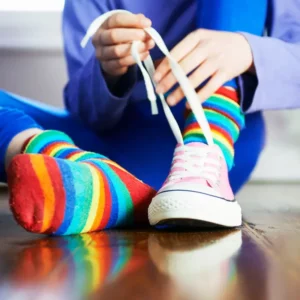Like shoe tying, kindness is a skill kids can practice! Check out the book I Am Kind: Kindness Practices for Kids today!
This article may contain affiliate links. If you decide to buy something through one of my links, it won’t cost you a penny more, and I may get a small commission. Thank you for reading and for supporting Belle Green!
When Do Kids Learn to Tie Shoes?
Of course each child is different, but the general consensus is that kids learn to tie shoes around the age of six. Certainly, there are many 5-year-olds who have mastered this skill, and others that don’t quite get a grasp until age 7. But by age 6, most kids have the fine motor skills to tie their shoelaces and enjoy a long life of making bows on their feet. 
So that’s great. But it doesn’t really answer the question I had, which is this: in the age of crocs and Velcro and flip-flops and other shoes that don’t have laces, does tying shoes really matter? I mean, my son successfully navigated a decade of life without lacing up a single sneaker. It didn’t seem to have stopped him from achieving anything, including doing other fine motor skill tasks like finger knitting, drawing details, and completing dozens of Lego kits.
I polled some fellow parents about this topic and there seemed to be two main schools of thought. The first is that learning to tie shoes is absolutely critical, with some parents refusing to buy kids shoes with Velcro until they’d successfully tied and worn shoes with laces. The other is that it’s not so much tying shoes that matters, but mastering bows, knots, and other activities that develop those fine motor skills.
Absolutely Essential
When I was growing up…um…in the 1980’s, Velcro was just beginning to really get big. So most of our shoes still had laces, and it would have been unheard of – and shameful – for a 10-year-old to not know how to tie their own shoes. (Cue shocked gasp and pearl clutching.) I didn’t have a pair of Velcro shoes until I was much older. Not having this skill would have been a serious life problem!
For those of us who grew up around this time, we probably associate normal childhood development with milestones like learning how to tie shoelaces. Lacking this ability would nearly be akin to not learning to speak. Perhaps that’s why many parents feel so strongly about learning to tie shoes. Or maybe it really is essential for developing fine motor skills?
It’s Not Shoes, But Knots and Bows That Matter
On the other hand, (or foot, in this case) there’s the position that the skill isn’t really shoe tying at all. It’s knots, bows, and developing the finger dexterity to perform these types of tasks that really matters. So if a child can’t necessarily “tie shoes” but they can tie knots, tie bows, and do other daily life essentials, do the shoes really matter? Do they need to learn to tie shoes specifically, or can that skill be acquired with other activities? Is shoe tying now going the way of learning to use a manual typewriter?
I have to say, even though I did grow up in the 80’s, I feel myself landing firmly in this camp. My son has done a ridiculous number of crafts in which he’s developed effective finger dexterity and fine motor skills. He learned to finger knit and now we have about a thousand finger knitted snakes all over our house. I don’t feel like he’s missed out on anything.
In addition, I feel like shoes with laces are just a pain in the bootie. They take longer to put on because you have to tie the laces. They come undone and you have to stop in the middle of life to tie them again. Sometimes laces break. If the laces are too tight or too loose, your shoe is uncomfortable. To be honest, I only have one tying pair myself. Only my running shoes have laces, and even then sometimes I wear slip-ons to go walking! (Honestly, this probably first started during pregnancy when bending down to lace or tie a sneaker was a logistical impossibility!)
Basic Shoe Tying Instructions
Even if you’ve known how to tie your shoes for decades, trying to explain to someone else, especially a child, what to do with those laces can be a bit tricky. In fact, it could be a bit like your debit card PIN – you know it unconsciously, and the moment you think about it, it’s gone. It’s too much pressure!
All jokes aside, you can totally feel confident in your ability to teach your children to tie their shoes without too much drama. And you should teach them, as this skill is usually not taught in school. I find the bunny ears method to be best, as it is simple to understand and easier for little fingers to perform. Here are verbal step by step instructions to try with your children to go along with a demonstration to help you teach your kiddos to tie their shoes. Also check out my step-by-step YouTube video.
Stop, Sit, and Prep
Make the Base
Make the Bunny Ears
Cross the Bunny Ears
Loop it Through
Pull and Tighten
Resources to Try to Teach Your Child How to Lace and Tie Shoes
Regardless of his actual need for shoe tying in daily life, I started to feel like I was falling down on the parenting job. So even though my son still doesn’t have any shoes that need to be tied, we set off on the journey of learning anyway. Without actual shoes of his own to practice on, we opted for some alternatives to work up to it, and once he got the hang of it, we could reward him with some shoes that tie. Here are the two products we used to teach him, and what he (and we) thought of each. (Watch him demo both here.)
Best Bet: How to Tie Your Shoes Board Book.
You can learn a new skill and add to your book collection with this aptly named How to Tie Your Shoes board book. This book is unique because it’s not just a descriptive story, it’s interactive with a front cover that is woven with laces. Kids can practice this new skill immediately after reading the book. It also covers how to tie several different types of knots and includes a cutout for the child to put together their own 3D cardboard shoe which they can then lace up. While the cut-out sneaker is obviously not the quality of the Melissa & Doug sneaker featured below, it’s fun to put together and can help keep kids interested in the whole learning process.
Between this book and the Melissa & Doug sneaker, my son and I both found the board book to be best for us in overall ease of use and more beneficial for his shoe tying journey. The laces are thicker and easier for small fingers to manipulate, and they are more like the laces kids will find on most types of sneakers. The DIY cardboard shoe in the book also gives a child new toy vibes and helps the overall activity of learning to tie shoes more interesting and engaging. Be sure to watch him demonstrate both products on the Belle Green YouTube channel. But when it comes down to it, the best way for a child to learn is to try, try again, and then get in some more practice!
Timeless Classic: Melissa & Doug’s Deluxe Wood Lacing Sneaker
Melissa & Doug products are well-known for their very high quality wooden toys for children, and their wood lacing sneaker is no exception. One of the benefits of this product is that kids can practice their shoe tying skills without tying up the use of actual shoe resources (haha, yes, I’m at it again). Kids can practice not just tying this wooden sneaker but also weaving the laces in and out. That makes it an ideal way to work on fine motor skills in general and shoe tying specifically. Our only complaint about the wooden sneaker is that the laces are thinner than you’ll find on most types of activewear shoes, although they are similar to those a child might have on specialty or dress shoes. This thinner shoelace size could be challenging and maybe not the best for smaller, less coordinated fingers.
Having a new toy is also one of the best ways to generate interest from a child (even if you got your sneaker second hand – it’s new to them!). Because it’s high-quality, this toy can easily be passed down from one child to the next, given to friends, donated, or later sold or traded at a swap meet. It’s also generally inexpensive, especially if you watch for a sale, so it’s not difficult to fit into the family budget.
Help kids develop those fine motor skills and learn their shapes at the same time! Download your Robot Shapes coloring and tracing pages today! See more.
Strong Foundations for Best Growth: Fine Motor Skill Development
The Five Benefits of Fine Motor Skill Development
The main benefits of children developing these skills can be summed up into five main categories: daily life, academic development, cognitive development, social skills, and self-esteem.
The first and most obvious is that they are essential to daily life. Tying shoelaces, buttoning clothes, zipping up jackets, and so on are pretty critical to getting through each day. They also help children become more independent.
Academic performance is also enhanced when children focus on developing these skills. Think about how much time a young child spends cutting with scissors, writing, painting or drawing, using rulers, etc. during lessons at school or projects at home.
As you demonstrated how to tie a shoe for your kids and helped walk them through the steps, you were also enhancing their cognitive development. At the same time they were making bunny ears, looping laces, and pulling laces, they were listening to, understanding, remembering, and following instructions. That’s a cognitive and motor skill task all in one.
Fine motor skills also help with social interactions. The better the fine motor skills a child has, the more they can participate in arts and crafts, board games, Lego build sessions, and other interactive occasions with other children. This also helps build the ability to work in teams!
Lastly, there’s the self-esteem and confidence aspects. Each time a child learns to do something new, it’s another win. One win at a time, they slowly build up to the independent, capable, and confident kid every parent hopes their child will be.
Motor Skill Milestones
While there’s many milestones for parents to keep track of – even during pregnancy (remember the first time you heard your baby’s heartbeat? Or felt your baby kick for the first time?) – here’s a few of those fine motor skills milestones to watch for. Keep in mind that YES each child is different, so these are general guidelines. But if you have any concerns about your child developing and performing these tasks adequately, don’t be shy about asking for expert help. A little bit of therapy, even done at home, can make a world of difference for a child!
Age 2
By age 2, most children have moved beyond the baby stage and can turn the pages of a book, use crayons to scribble, and build a tower with blocks. They will also begin to solve simple puzzles and use utensils (complete with all the messes!). Young children learn about their word chiefly by experiencing it, so make sure they have lots of opportunities to explore!
Age 3
Your baby isn’t a baby anymore! Around age 3, you should notice that your child can undress themselves (perhaps at inopportune times – ask me how I know), are progressing in their art skills by drawing circles and crisscrosses, and improving on their use of utensils. They’ll also start to solve slightly more complicated puzzles.
Age 4
By age 4 most children are showing greater coordination and control with crayons, pencils, safety scissors, and other art supplies when working on creative tasks like a happy anniversary coloring page or in a Pokémon coloring book. They’ll get better at teeth brushing, manage smaller buttons, and perhaps begin to tie shoelaces. These are all great skills for preparing children for school.
Age 5
Age 5 is exciting because by this age most kids are starting school and rapidly progressing in their fine motor skills. They may be able to write their own name, dress and undress on their own, fold paper, and create more detailed works of art. (They also love to ask endless questions like what rhymes with taco!)
Again, these are just generalizations. Each child develops at different rates, sometimes advancing rapidly, then remaining steady for a while before another leap. But it is fun to keep a chart of some kind on hand to check off these skills as you see them emerge in your child!
Growing Together is the Best Way!
Become a Greenie!
Join my subscribers list and get a FREE PDF copy of Everyday Special Events Family Coloring Pages! These 12 fun coloring pages for kids include Happy Birthday, Get Well, First Day of School, Last Day of School, Happy New Year, Congratulations, and more! Just download and print!
Your data is safe here! I never sell or share email addresses.




